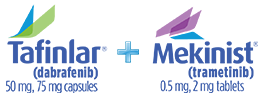
Safety Profile
Adverse Reactions (Adult)
The safety of TAFINLAR + MEKINIST in adults with BRAF V600E–mutant solid tumors was determined by the ROAR Study.1,2
Adverse reactions (≥20%) in adult patients taking TAFINLAR + MEKINIST1,2,a
| TAFINLAR + MEKINIST (N=206) | |
Adverse Reactions | All grades, % | Grade 3 or 4, % |
General | ||
Pyrexia | 55 | 4.9 |
Fatigueb | 50 | 5 |
Chills | 30 | 0.5 |
Edema peripheralc | 22 | 0 |
Gastrointestinal | ||
Nausea | 40 | 1.5 |
Constipation | 27 | 0 |
Vomiting | 27 | 1.5 |
Diarrhea | 26 | 2.9 |
Skin | ||
Rashd | 40 | 2.4 |
Nervous system | ||
Headache | 30 | 1.5 |
Vascular disorders | ||
Hemorrhagee | 29 | 4.4 |
Respiratory | ||
Coughf | 29 | 0 |
Musculoskeletal and connective tissue | ||
Myalgiag | 24 | 0.5 |
Arthralgia | 23 | 0.5 |
aNational Cancer Institute Common Terminology Criteria for Adverse Events version 4.0.
bIncludes fatigue, asthenia, and malaise.
cIncludes edema peripheral and peripheral swelling.
dIncludes rash, rash maculo-papular, rash erythematous, rash pustular, and rash papular.
eIncludes epistaxis, hematuria, contusion, hematoma, hemoptysis, conjunctival hemorrhage, hematochezia, rectal hemorrhage, hemorrhoidal hemorrhage, melena, purpura, eye contusion, eye hemorrhage, gastric hemorrhage, gingival bleeding, hematemesis, hemorrhage intracranial, hemorrhagic stroke, hemothorax, increased tendency to bruise, large intestinal hemorrhage, mouth hemorrhage, petechiae, pharyngeal hemorrhage, prothrombin time prolonged, pulmonary hematoma, retinal hemorrhage, vaginal hemorrhage, and vitreous hemorrhage.
fIncludes cough and productive cough.
gIncludes myalgia, musculoskeletal chest pain, and musculoskeletal pain.
Serious adverse reactions (ARs) occurred in 45% of patients who received TAFINLAR + MEKINIST1,2
— Serious ARs in >5% of patients included pyrexia (11%) and pneumonia (6%)
Fatal ARs occurred in 3.9% of patients who received TAFINLAR + MEKINIST1,2
— Fatal ARs that occurred in >1% of patients included sepsis (1.9%)
Permanent treatment discontinuation due to an AR occurred in 13% of patients1,2
— ARs that resulted in permanent treatment discontinuation in >1% of patients included nausea (1.5%)
Dosage interruptions due to an AR occurred in 55% of patients1,2
— ARs that required dosage interruption in >5% of patients included pyrexia (22%), chills (9%), fatigue (6%), neutropenia (6%), and nausea (5%)
Dose reductions due to an AR occurred in 44% of patients1,2
— ARs that required dose reductions in >5% of patients included pyrexia (18%), chills (8%), and fatigue (6%)
Adverse Reactions (Pediatric)
The safety of TAFINLAR + MEKINIST in pediatric patients with BRAF V600E–mutant solid tumors was determined by the X2101 Study.1,2
Adverse reactions (≥20%) in pediatric patients taking TAFINLAR + MEKINIST1,2,a
| TAFINLAR + MEKINIST (N=48) | |
Adverse Reactions | All grades, % | Grade 3 or 4, % |
General | ||
Pyrexia | 75 | 17 |
Fatigueb | 48 | 0 |
Skin | ||
Rashc | 73 | 2.1 |
Dry skin | 48 | 0 |
Dermatitis acneiformd | 40 | 0 |
Gastrointestinal | ||
Vomiting | 52 | 4.2 |
Diarrhea | 42 | 2.1 |
Abdominal paine | 33 | 4.2 |
Nausea | 33 | 2.1 |
Constipation | 23 | 0 |
Respiratory | ||
Cough | 44 | 0 |
Nervous system | ||
Headache | 35 | 0 |
Vascular disorders | ||
Hemorrhagef | 33 | 0 |
Infections | ||
Paronychia | 23 | 0 |
aNational Cancer Institute Common Terminology Criteria for Adverse Events version 4.0.
bIncludes fatigue, asthenia, and malaise.
cIncludes rash, rash maculo-papular, rash erythematous, rash papular, rash pustular, and rash macular.
dIncludes dermatitis acneiform and acne.
eIncludes abdominal pain and abdominal pain upper.
fIncludes epistaxis, hematuria, contusion, hematoma, petechiae, rectal hemorrhage, and red blood cell count decreased.
Serious ARs occurred in 46% of patients who received TAFINLAR + MEKINIST1,2
— Serious ARs in >5% of patients included pyrexia (25%) and ejection fraction decreased (6%)
Permanent treatment discontinuation due to an AR occurred in 21% of patients1,2
— ARs that resulted in permanent treatment discontinuation in >3% of patients included alanine aminotransferase increased (6%), aspartate aminotransferase increased (4.2%), and ejection fraction decreased (4.2%)
Dosage interruptions due to an AR occurred in 73% of patients1,2
— ARs that required dosage interruption in >5% of patients included pyrexia (56%), vomiting (19%), neutropenia (13%), rash (13%), ejection fraction decreased (6%), and uveitis (6%)
Dose reductions due to an AR occurred in 25% of patients1,2
— ARs that required dose reductions in >5% of patients included pyrexia (13%)
In the pediatric pooled safety analysis for Study G2201 and Study X2101 (N=166 across both trials), the most common (>20%) adverse reactions were pyrexia (66%), rash (54%), headache (40%), vomiting (38%), musculoskeletal pain (36%), fatigue (31%), dry skin (31%), diarrhea (30%), nausea (26%), epistaxis and other bleeding events (25%), abdominal pain (24%), and dermatitis acneiform (23%)1,2
